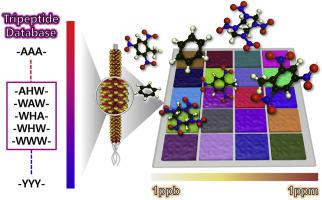Biosensors and Bioelectronics ( IF 12.6 ) Pub Date : 2021-01-13 , DOI: 10.1016/j.bios.2021.112979 Jungyun Park , Jong-Min Lee , Hoje Chun , Yujin Lee , Sung Jun Hong , Hyunwook Jung , Ye-Ji Kim , Won-Geun Kim , Vasanthan Devaraj , Eun Jung Choi , Jin-Woo Oh , Byungchan Han

|
Genetic engineering of a bacteriophage is a promising way to develop a highly functional biosensor. Almost countless configurational degree of freedom in the manipulation, considerable uncertainty and cost involved with the approach, however, have been huddles for the objective. In this paper, we demonstrate rapidly responding optical biosensor with high selectivity toward gaseous explosives with genetically engineered phages. The sensors are equipped with peptide sequences in phages optimally interacting with the volatile organic compounds (VOCs) in visible light regime. To overcome the conventional issues, we use extensive utilization of empirical calculations to construct a large database of 8000 tripeptides and screen the best for electronic nose sensing performance toward nine VOCs belonging to three chemical classes. First-principles density functional theory (DFT) calculations unveil underlying correlations between the chemical affinity and optical property change on an electronic band structure level. The computational outcomes are validated by in vitro experimental design and testing of multiarray sensors using genetically modified phage implemented with five selected tripeptide sequences and wild-type phages. The classification success rates estimated from hierarchical cluster analysis are shown to be very consistent with the calculations. Our optical biosensor demonstrates a 1 ppb level of sensing resolution for explosive VOCs, which is a substantial improvement over conventional biosensor. The systematic interplay of big data-based computational prediction and in situ experimental validation can provide smart design principles for unconventionally outstanding biosensors.
中文翻译:

通过遗传工程噬菌体实现的对挥发性有机化合物具有出色灵敏度和选择性的光学生物电子鼻:多尺度计算预测和实验验证的集成研究
噬菌体的基因工程是开发功能强大的生物传感器的有前途的方法。然而,该方法几乎束缚了该操作的配置自由度,相当大的不确定性和成本。在本文中,我们展示了对具有遗传工程噬菌体的气态炸药具有高选择性的快速响应的光学生物传感器。传感器配备了噬菌体中的肽序列,可在可见光条件下与挥发性有机化合物(VOC)最佳相互作用。为了克服常规问题,我们广泛使用了经验计算方法,以构建一个大型的8000个三肽数据库,并针对属于三种化学类别的九种VOC筛选出最佳的电子鼻感测性能。第一性原理密度泛函理论(DFT)的计算揭示了化学亲和力与电子能带结构水平上的光学性质变化之间的潜在相关性。计算结果通过以下方式验证体外实验设计和测试,使用转基因噬菌体和五种选定的三肽序列和野生型噬菌体实施多阵列传感器。从层次聚类分析估计的分类成功率与计算非常一致。我们的光学生物传感器证明了爆炸性VOC的感测分辨率为1 ppb,这是对传统生物传感器的实质性改进。基于大数据的计算预测与原位实验验证的系统性相互作用可以为非常规出色的生物传感器提供智能设计原理。



























 京公网安备 11010802027423号
京公网安备 11010802027423号